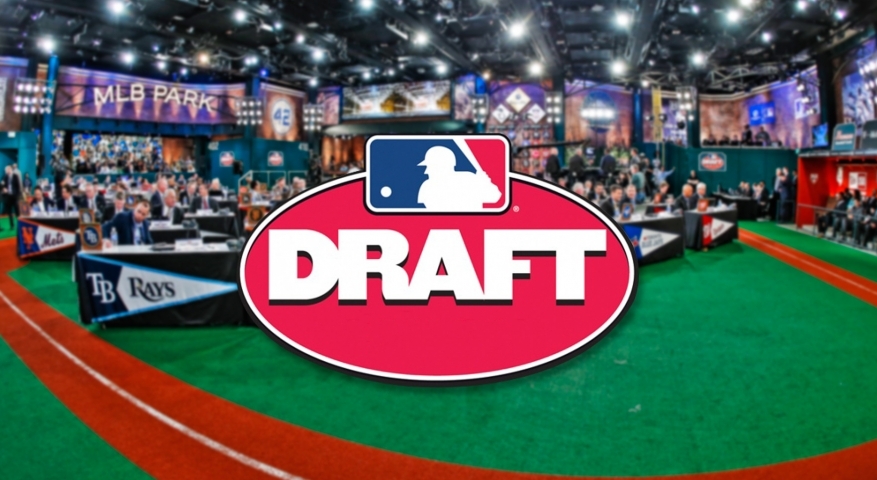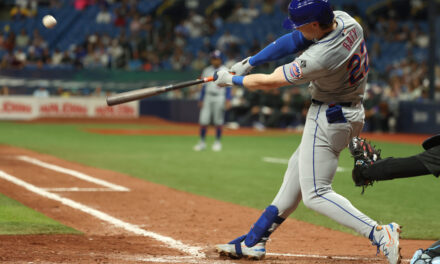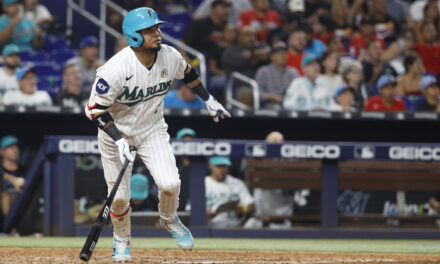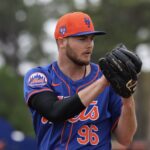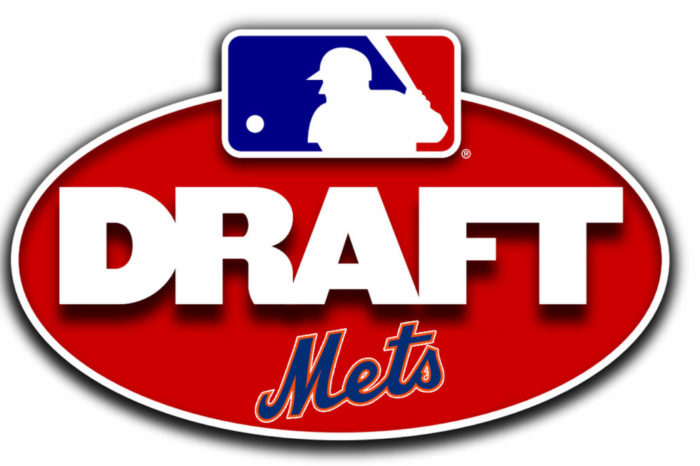
It’s finally here! The day of new Mets, as the first day for prospective players are drafted and new baseball careers for those whose names are called. After the abysmal year in 2017, the Mets have been given the No. 6 pick in the draft to choose a player who could possibly help their team and provide real impact.
The No. 6 pick is the highest they have had since 2004, when they picked Philip Humber, who was selected third overall. This event starts tonight at 7:00, where the first 43 picks, first round and Competitive Balance Round A are aired on MLB Network.
The subsequent 35 including second round and Competitive Balance B will be aired on MLB.com. Then on Tuesday, teams will pick from rounds third to 10th, starting at 1:00 p.m. The draft will then conclude on Wednesday with teams selecting the 11th to 40th picks starting at noon, again on MLB.com.
Major League Baseball is unlike any other sport when it comes to assessing players. A baseball player, no matter what round selected, will be part of an arduous process that can start at rookie-ball or short season, and traverse 5-7 levels to get to Major Leagues.
At the time of the draft, a team can look at a player and see how they can work with them and only hope that this player will realize the potential the team has for them. During that time, other things can happen that are not foreseeable, such as injuries, behavioral issues, vision problems, team chemistry issues. Between now and the finish, the variables that happen to a player are too great to predict the future of the player an organization selects, and this happens to any organization, not just yours.
The draft also plays out a strategy. Each team is allotted a certain number of money that the team is allowed to give to players. The amount of money is recommended to be given from the top pick to the tenth rounder in declining figures, pick by pick.
After the tenth round, there is a $125,000 slot, unless there is leftover slot due to some picks not getting the recommended amount. The extra money from the pool can be applied to later round picks that have a bonus in excess of $125k, however, giving under the $125k slot in later rounds does not reserve more money to other picks. If the team does not sign a player that was in their top ten picks, they will forfeit the money that was in that recommended slot range and cannot use it to sign other picks outside the top ten.
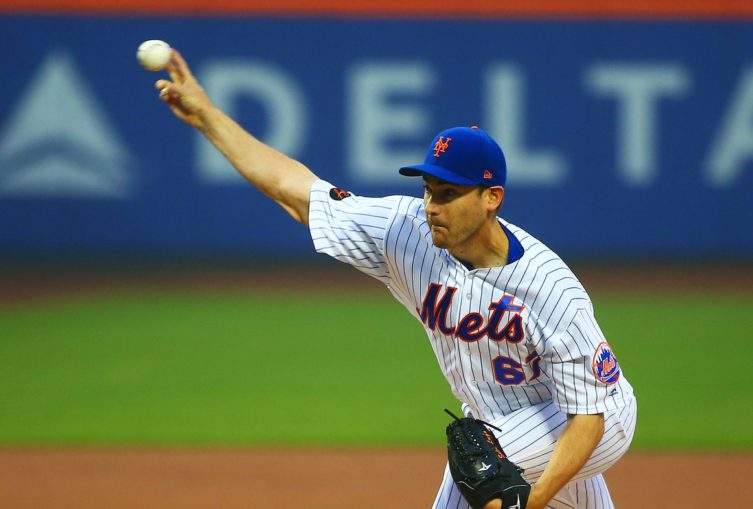
While some would not allow the gamble of giving money to picks not considered for rounds 1-10, keep in mind that several later rounders such as Seth Lugo (34th round), Daniel Murphy (13th round), and Collin McHugh (18th round) can be useful as well. The Mets bonus pool this year is $9,580,900.
The pick’s slot values are set up like this:
- Pick #6, $5,525,00
- Pick #48, $1,485,100
- Pick #83, $703,300
- Pick #110, $507,800
- Pick #140, $379,400
- Pick #170, $285,200
- Pick #200, $222,300
- Pick #230, $176,700
- Pick #260, $152,100
- Pick #290, $141,800
Currently at No. 6, the Mets are tied to several players. From what we had heard, Omar Minaya has taken the reins for the top two picks for the Mets this year before giving the other 38 to the scouting director, Marc Traumuta. Knowing what Omar has said in the past about his preferences, the Mets will be looking at athletes, and here are some of top athletes possibly on the board at No. 6:
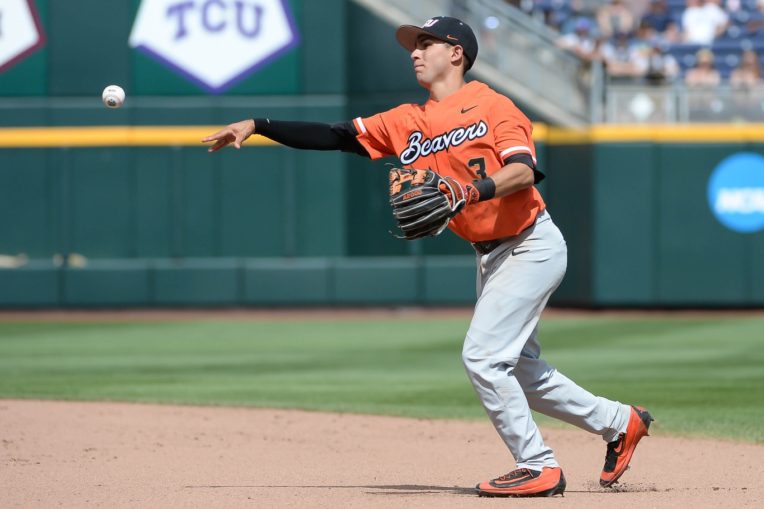
2B/SS Nick Madrigal, Oregon State
Madrigal is unconventional for the top ten in a few ways. First of all, he’s a 2nd baseman, which is a position usually not taken in the top ten picks. While he can play shortstop, with an average arm, great fielding, and great range, he has not been due to a superior defensive shortstop in Cadyn Grenier being available. Second, he’s small for a player at 5’7″ 160 lbs, which is usually too small for the top ten picks, but he is an outlier for a reason.
Madrigal is an incredible athlete, with plus-plus speed, and great defense at 2nd base. But that isn’t the most value, as Madrigal is the best hitter in college, but missed half the season due to breaking his wrist sliding into home early in the season. He is capable of hitting for high average and on base percentage and continue to barrel the ball. Unfortunately because of size, he has projected below-average power. Nonetheless, he projects to be a .300/12-15 hr, 30 steal player with leadoff potential. It’s likely Madrigal will be picked before #6.
OF Travis Swaggerty, University of South Alabama
Swaggerty, armed with an 80 name and some great athleticism, Swaggerty had early helium coming into the draft. A guy who went undrafted out of high school and goes to a college with a small Division 1 conference, Swaggerty has done nothing but hit since freshman year. Swaggerty earned high-round draft status after destroying the ball over the summer as a center fielder for College’s Team USA, and playing a great center field.
He did little to dissuade scouts this spring, hitting for more power, upping his walk percentage, and dropping his strikeout percentage. The total package of Swaggerty includes plus speed, making him able to cover center field with ease, with an above-average arm and above-average power. Swaggerty has a good idea what to do at the plate, and can post a good on-base percentage. If I were looking at a good comp for Swaggerty, it would be Andrew Benintendi.
3B Jonathan India, University of Florida
India was a top high school bat in the 2015 draft with athleticism across the board, but was drafted in the late rounds due to being a tough sign. Instead of going pro, India attended University of Florida, Peter Alonso‘s alma mater. During his first two years as a Gator, India did not hit for much power, hitting 10 homers in his first two seasons, and walking 8.5% of the time.
This year, he made a few tweaks, doubling his walk percentage up to 19% and doubled his power production, hitting 17 homers. For a majority of the year, India was hitting over .380, and getting on base over half the time, while slugging over .700, and playing a superb third base, and stealing a few bases. Because of his overall performance, India became Southeastern Conference’s Player of the year.
India provides a good package, showing power and patience, while having athleticism in the field, with above average defense and arm at the hot corner, and average speed for good instincts in the field. India makes a lot of sense for the Mets with his performance and athleticism, and has been heavily mocked to the Mets in the last month.

Photo by Bill Mitchell, Baseball America.
OF Jarred Kelenic, Waukesha West HS, Wisconsin
This seems familiar, an athlete from a cold-weather state in the first round. Remember the last time we drafted one of those? Kelenic has no helium, he just has always been a top bat in this draft, and always stayed in the top-15 projected picks.
Kelenic is the athletic type that has great upside as a left handed center fielder who can just hit. An above-average to plus runner, Kelenic can go get balls in the gap with ease as a center fielder, and takes great routes to run down that ball. However with age, and some added projection, he may add some bulk and settle into a corner outfield spot.
Luckily, he has a bat that may show itself to work in any position. Kelenic has a sweet swing from the left side, and hits for above average power, with plus raw to harness. Showing how well Nimmo did, coming from an unconventional state, picking Kelenic may be lightning striking twice. Mets have been looking at College Players, but Kelenic may be too good to pass up.
LHP Matthew Liberatore, Mountain Ridge HS, Arizona
Probably the top lefty in the draft, Liberatore has been speculated for the top ten picks for the entire season. Already at 6’5″, 200 lbs, Liberatore is tall and full of projection. While he doesn’t throw hard, pitching at 89-94, he’s got great command, which is unconventional for a young lefty and features a plus curve, above average slider, and changeup. At times this past spring, he has touched 97, but has not kept that consistent enough yet. Nevertheless, scouts love his great, projectable frame and his potential to be a reliable starter down the road.
3B/1B Alec Bohm, Wichita
Recently mocked to the Mets this morning by MLB.com, Alec is a bat with high potential, offensively. With an above-average bat and plus power, Alec could be a force to be reckoned with. After hitting .351 with five home runs in the Cape, Bohm solidified his standing in the first round with the Cape League All Star Team.
This year for Wichita he also increased his power production while walking more than he struck out after his first two years in the inverse. While Bohm’s bat is one of the top in college, he isn’t super athletic, as a below-average runner, with below-average lateral range, and an average arm, putting him in question as a third baseman in the long run. He’ll have plenty of bat as a first baseman, but versatility and athleticism aren’t in the cards for him.
Potential Round 2 draft picks:
OF Parker Meadows: The younger brother of Austin Meadows, a top prospect of the Pirates. Parker is a power-speed combo.
OF Griffin Conine: Son of Jeff Conine with plus power and a RF profile. Didn’t hit for his first month, and then went on fire for the rest of the year. He lost his first round standing, but still is a potent bat.
RHP Blaine Knight: Arkansas’s ace, who throws from 90-94 and touches 97 with three above average pitches.
RHP Lenny Torres: A pitcher out of the local confines of Beacon HS in New York, Lenny can touch 97, and usually sits around 93. He also has the makings of a plus slider, but needs more command and some more feel for his changeup.
OF Tristan Pompey: Daulton Pompey’s younger brother has some potential of his own. A switch hitting, athletic outfielder, he has some speed and power, but is raw as an outfielder.
Past 10 years of top draft picks and their highest level played:
- 2017: LHP David Peterson, A-Ball Columbia
- 2016: RHP Justin Dunn, Hi-A St. Lucie, Anthony Kay, Columbia
- 2015: OF Desmond Lindsay, St. Lucie
- 2014: OF Michael Conforto, MLB
- 2013: 1B Dominic Smith, MLB
- 2012: SS Gavin Cecchini, MLB, C Kevin Plawecki, MLB
- 2011: OF Brandon Nimmo, MLB, RHP Michael Fulmer, MLB
- 2010: RHP Matt Harvey, MLB
- 2009: LHP Steven Matz, MLB
- 2008: 1B Ike Davis, MLB, SS Reese Havens, AAA
The final mock from Baseball America was recently released with them thinking the Mets take prep outfielder Jarred Kelenic.
Let’s have a good draft and hopefully pick some Mets we will see in the show!


